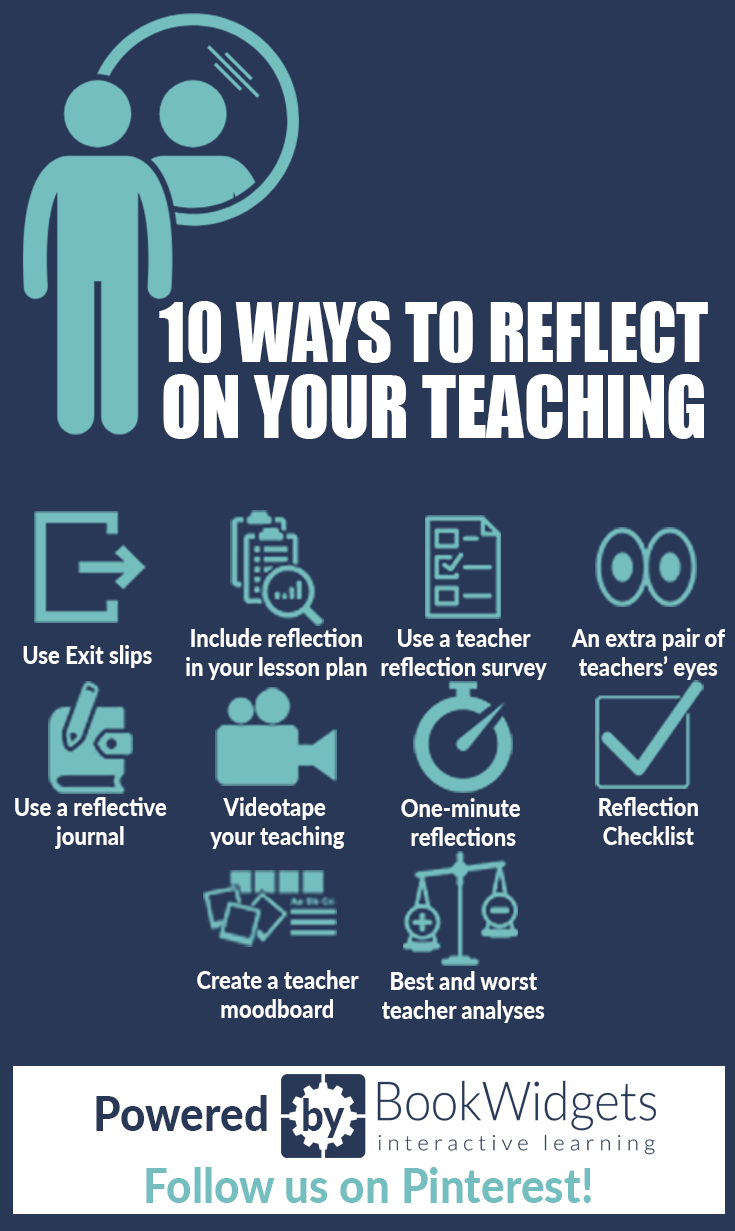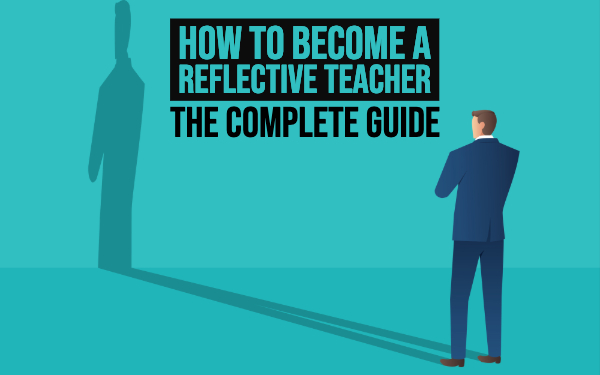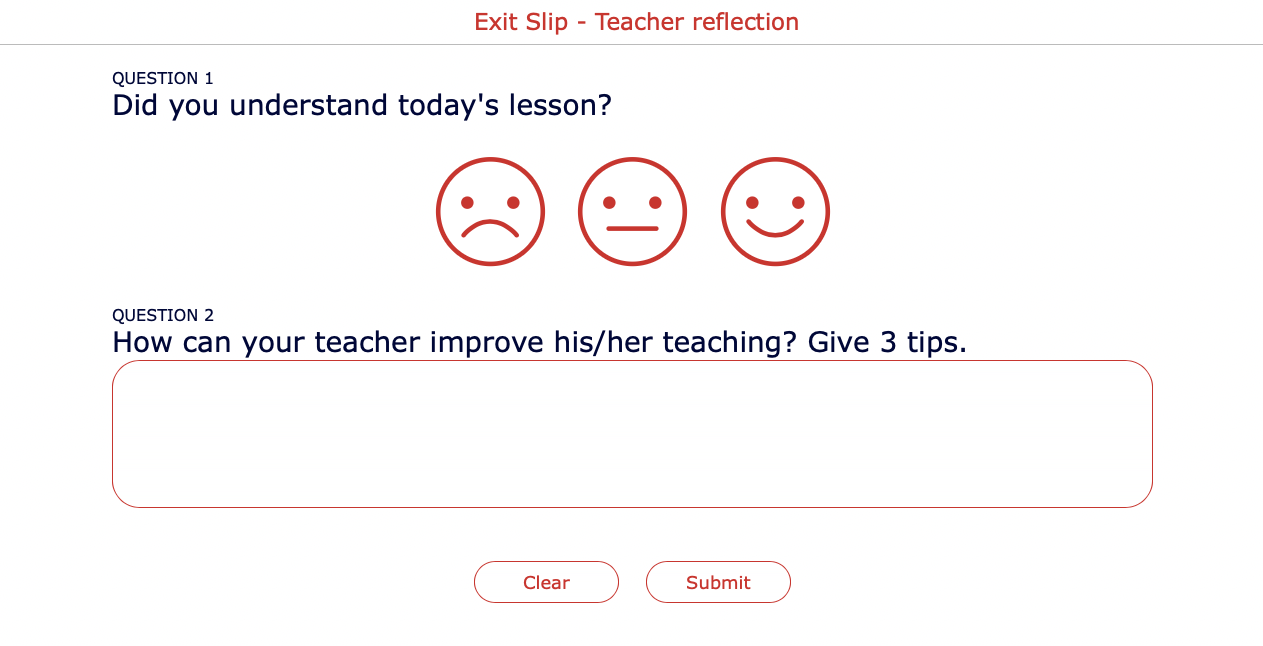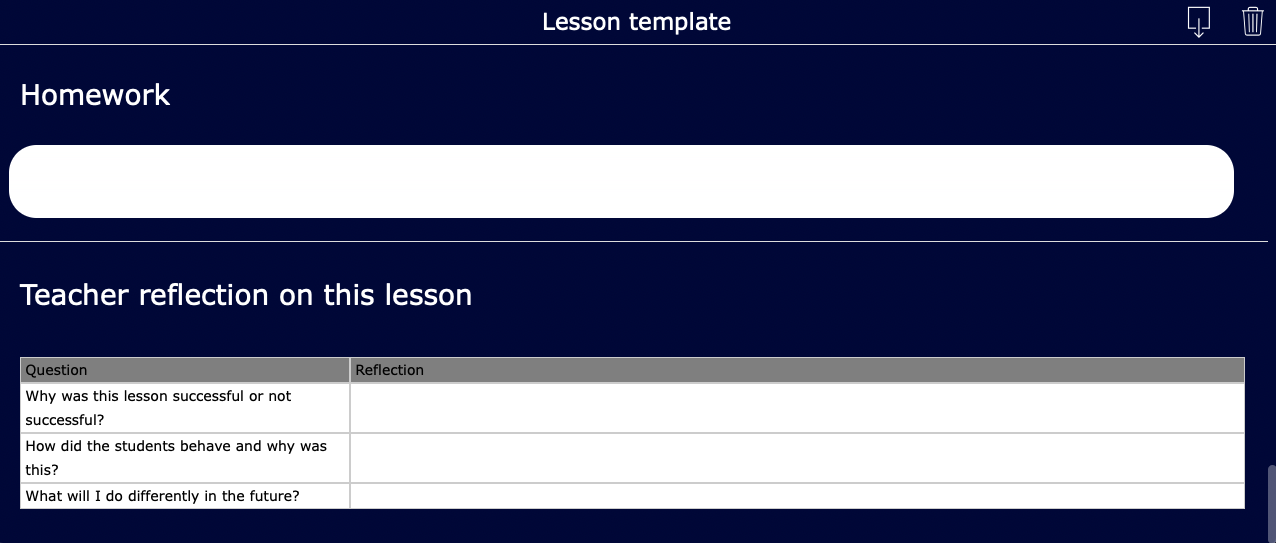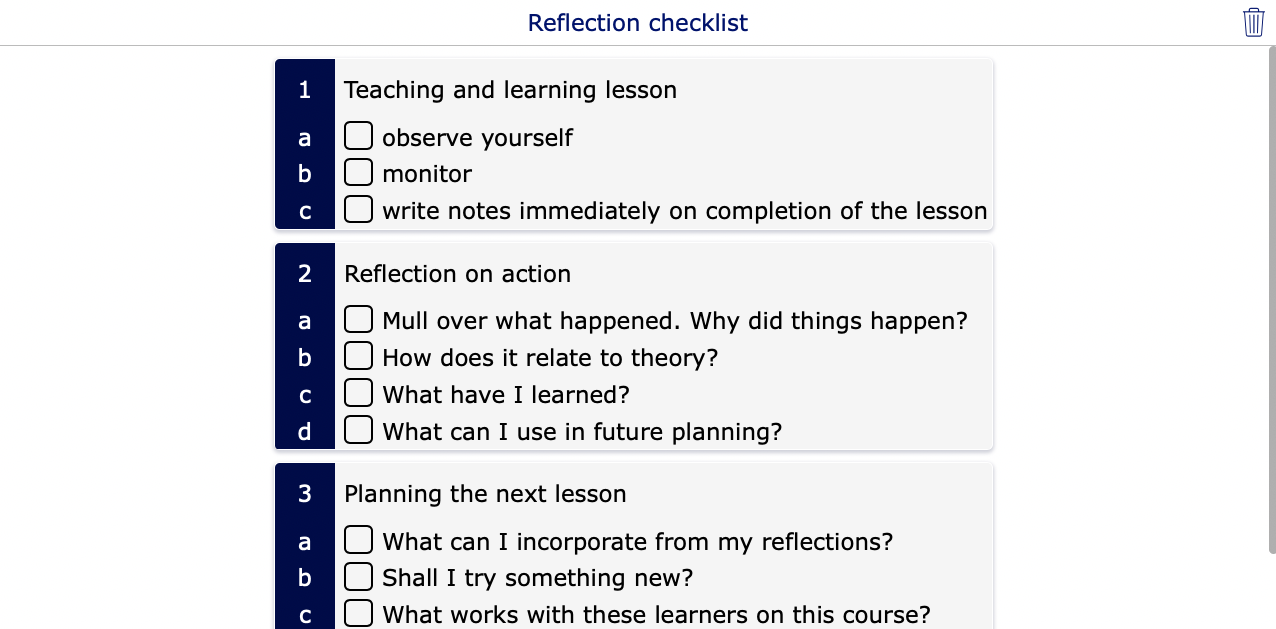How to become a reflective teacher - The complete guide for reflection in teaching
 Lucie Renard —
Lucie Renard —
“Self-reflection is the school of wisdom.” – Baltasar Gracian
If you reflect on yourself, you’ll enter the gates of wisdom. Or the school gate…
Learning is what your students do in school. But not only the students are there to learn: the teacher is too. To become a better version of yourself, you must embrace feedback and criticism and reflect on your own teaching.
“Easier said than done”, I hear you say. Some teachers are masters in self-reflection, but not everyone has that same gift. That’s why I want to give you some tips on how you can reflect on your teaching.
In this blog post I listed 10 ways that encourage reflective teaching. On top of that, I added some teacher self-reflection examples and reflection templates you can use in your classroom.
But first:
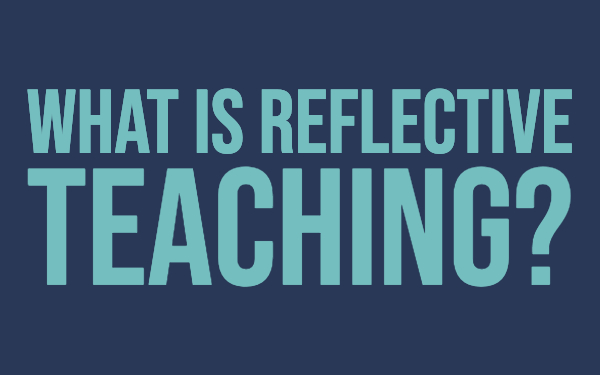
What is reflective teaching?
Reflective teaching means that you take a look at what you do in your classroom, and think about why you do it. Then, think about whether this works for your students and for yourself.
Why is reflection important in teaching? Well, when reflecting, you’re collecting information about what goes on in your classroom. When analysing and evaluating this new information, you can identify and explore your own practices and underlying beliefs, which may lead to changes and improvements in your teaching.
Reflective teaching is an example of professional development, starting in your own classroom.
The process of reflection comes with a cycle to follow:
- Teach
- Self-assess the effect of your teaching on learning
- Consider new ways of teaching that can improve the quality of learning
- Try these ideas in practice
And of course, repeat the process again: self-reflection never stops, even if you’re an old hand that has been on the job forever.
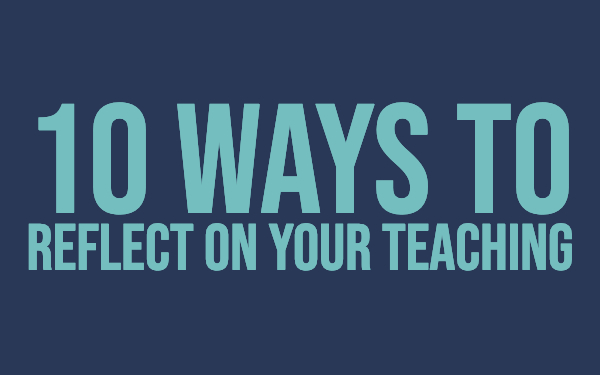
10 Ways to reflect on your teaching
To get a clear view about the state of your teaching, you’ll have to gather information first. There are a few ways to do this, using the reflection activities below.
1. Use exit slips
 An exit slip (a.k.a. exit ticket) is a great way to quickly gauge student understanding at the end of a lesson. It gives you a snapshot of how well students understood today’s lesson, so you can tell whether you can start building the next layer.
An exit slip (a.k.a. exit ticket) is a great way to quickly gauge student understanding at the end of a lesson. It gives you a snapshot of how well students understood today’s lesson, so you can tell whether you can start building the next layer.
Of course, an exit ticket can also be used to gather information about your teaching instead of the lesson content.
Ask your students 2 questions at the end of the lesson that concern your teaching. Here’s an example:
Your students’ answers will appear in your inbox, along with a nice overview in BookWidgets (if you’re using this exit slip reflection example).
If you want to use (or change) this exit slip example, make sure to make a copy of it in your BookWidgets account (Which you can create for free).
2. Include reflection in your lesson plan
 When building your lessons, you have to create a lesson plan. It’s a good idea to leave a blank space at the bottom of your lesson plan. This place can be used to evaluate your own teaching and to reflect on it.
When building your lessons, you have to create a lesson plan. It’s a good idea to leave a blank space at the bottom of your lesson plan. This place can be used to evaluate your own teaching and to reflect on it.
Check out this digital lesson template example with a teacher lesson reflection area at the bottom.
You can use this digital lesson plan template as many times you want. Here’s how it works:
- Fill out your lesson plan
- Download your complete lesson plan (click on the download button in the upper right corner).
- Save your completed lesson plan on your computer.
When you’re done, you can just clear the template and start over again. Or, you can just use this as an example. If you want to make some changes to the template, click here and make a copy of the template.
3. Use a teacher reflection survey
 Another obvious option to reflect on your teaching is giving your students a survey that they can fill out anonymously.
Another obvious option to reflect on your teaching is giving your students a survey that they can fill out anonymously.
I’ve created one for you here:

If you want to use (or change) this survey example, make sure to make a copy of it in your BookWidgets account (which you can create for free). Otherwise, your students’ results will fill up my inbox 😉 .
All the survey results are poured into some great charts and percentages so you get a nice overview and know what areas of your teaching need some more work.
4. An extra pair of teacher’s eyes
 Besides your students giving you some useful input, you can also use an extra pair of teacher’s eyes. Ask a fellow teacher to follow your class for an hour or a day.
Besides your students giving you some useful input, you can also use an extra pair of teacher’s eyes. Ask a fellow teacher to follow your class for an hour or a day.
This teacher is also a professional, and therefore knows what aspects of your teaching need some attention. They can give you some useful tips regarding your teaching and you can return the favor. Of course, some positive feedback is always welcome and the other teacher may learn from you as well by just looking at how you teach your students.
5. Use a reflective journal
 Keep a notebook within reaching distance so you can write down comments
and observations any time during your lesson (or shortly afterwards).
Keep a notebook within reaching distance so you can write down comments
and observations any time during your lesson (or shortly afterwards).
Notes can include highlights of lectures and assignments that worked well, errors that need to be adjusted, and stuff that simply failed and needs to be reworked or cut out completely.
It’s very easy to look back and to keep these comments in mind for your next lesson.
6. Videotape your teaching
 Sometimes, it’s handy to just videotape the complete lesson. This way,
you can look back at your teaching yourself. Here, you not only reflect on your
teaching, you also reflect on your body language and classroom management. The
video recording might show you some things you didn’t notice when you were
teaching.
Sometimes, it’s handy to just videotape the complete lesson. This way,
you can look back at your teaching yourself. Here, you not only reflect on your
teaching, you also reflect on your body language and classroom management. The
video recording might show you some things you didn’t notice when you were
teaching.
This is a reflection on teaching you can’t use all the time. You have to make sure your students feel comfortable enough with a video camera in the room, even if it’s only pointed at you.
7. One-minute reflections
 If you’re not much of a writer, it’s really handy to just record your
reflection on your smartphone. Every smartphone has a voice-recording app. Make
some time after each lesson to quickly record what went great and what went bad
during your lesson. Just that. One minute, and you’re done.
If you’re not much of a writer, it’s really handy to just record your
reflection on your smartphone. Every smartphone has a voice-recording app. Make
some time after each lesson to quickly record what went great and what went bad
during your lesson. Just that. One minute, and you’re done.
Make sure to label your recordings correctly, so you could still use them afterwards. If you’re not going to use them, there’s no use of reflecting on your teaching.
8. Reflection practice checklist
 Self-reflection is a process. Below, I wrote down the process that’s most used to reflect on a teacher’s teaching. Just follow the next steps in this digital checklist.
Self-reflection is a process. Below, I wrote down the process that’s most used to reflect on a teacher’s teaching. Just follow the next steps in this digital checklist.
This is a reflection resource for teachers you can use any time. Check the steps if finished so they will dissolve.
9. Create a teacher moodboard
 When you first start teaching, you have this ideal dream of being the
best teacher there is. Your students will adore you and you will inspire them.
You’ll be that cool teacher, with all the jokes that your students find
hilarious. LOL 🤣
When you first start teaching, you have this ideal dream of being the
best teacher there is. Your students will adore you and you will inspire them.
You’ll be that cool teacher, with all the jokes that your students find
hilarious. LOL 🤣
Then, you start your first teaching job and you struggle to achieve that goal of becoming the perfect teacher. You’re not alone. It’s just a part of the “becoming a teacher” process. Sometimes, you’ll have to take a 🥊 in the face.
Many teachers give up trying to become a better teacher, but you won’t. To pursue your dream, you can create a teacher moodboard at the start of your teaching career. Back when you were still dreaming big. It will serve as a reminder to never give up.
A teacher moodboard may include people you look up to, inspiring quotes that give you perseverance, words that define you and much more. In this modern time, we just call this a Pinterest Board.
Once in a while, you have to look back at this board so it helps you reflect on the teacher you are now and the teacher you wanted to become in the first place. It’s never too late to change old habits and rusty lessons.
10. Best and worst teacher analyses
 This is a reflection exercise you can do in a group, with your fellow
teacher colleagues. Here’s how it goes:
This is a reflection exercise you can do in a group, with your fellow
teacher colleagues. Here’s how it goes:
- Think about your best teacher when you were a student.
- List the top 5 personal qualities, skills or attitudes which made them so good.
- Now, think of your worst teacher.
- List the top 5 personal qualities, skills or attitudes which made them so bad.
- Get your heads together. As a group, identify if any of these “themes” you wrote down occur several times.
- Make a top 5 of the group.
Now you have a list with qualities, skills or attitudes you want to adopt or get out the way as a teacher yourself.
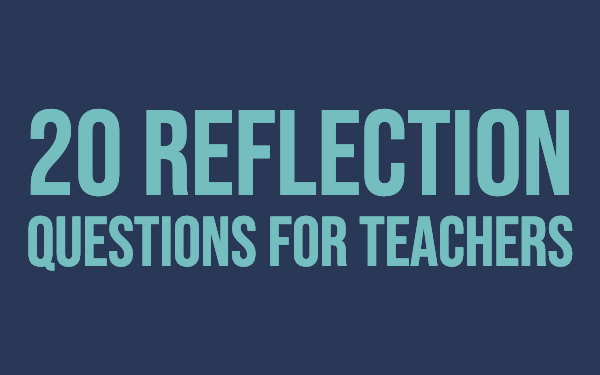
20 reflection questions for teachers
In the reflection approaches above, you’ll already find some reflection resources for teachers. And of course, there’s more. I listed some other important question prompts you can ask yourself when reflecting on your teaching abilities. The reflection questions are divided in different categories:
Reflection questions to ask with students
- Did this lesson help you understand other lessons better? Why?
- If we learn this lesson again, what can I do differently to help you learn more or better?
- Why was this activity successful or not successful?
- What did you like about this lesson?
- What did you dislike about this lesson?
Reflection question about assessment and grading
- Do my assessments reflect student learning, or just task completion and memorization skills?
- Do all students benefit from this learning method/activity? Who does and who doesn’t? Why?
- Why did I choose this method/activity to cover this topic?
- How can I know my students are learning? Evidence?
- What new strategies can I try later on that might benefit a student that I’m struggling with?
Reflection questions about classroom management
- Do I give my student opportunities to make their own choices?
- Do I know my students outside of the classroom? Do I know something about their personal lives?
- Could pre-teaching my expectations or developing rules/procedures help solve the problems I have in my classroom?
- Is the relationship that I have with my students helping/hindering their ability to learn?
- Was my attitude towards my class today effective for student learning?
Reflection questions for teachers’ professional development
- In what ways can I support my colleagues in their student’s learning?
- In what aspects can I still improve my teaching?
- What’s stopping me from improving in these aspects?
- What opportunities are there to improve myself as a teacher?
- Do my actions as a teacher show that I take pride in my work?
Wrap up
So, that’s a whole lot of new information! I hope this post about reflection practice in education helps you to be a better teacher (though I’ve never doubted your capabilities! 😊)
Which way of reflection do your prefer? Let us know on Twitter and join our Teaching with BookWidgets Facebook group to stay up to date on new blog posts!
Don’t forget to say hi 👋 and connect with me on LinkedIn.
Now, go rock that classroom!
